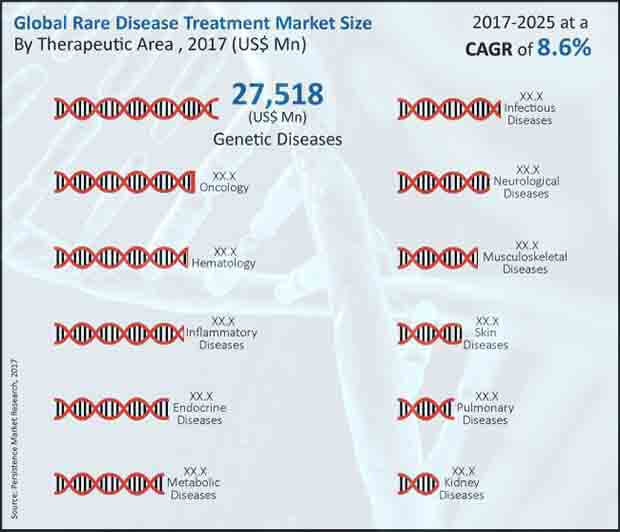Rare Disease Treatment Market Segmented By Hematology, Genetic Diseases, Neurological Diseases, Oncology Infectious Diseases, Inflammatory Diseases, Metabolic Diseases Therapeutic Area with Originator Drugs, Generic Drugs Type with Biologics, Organic Compounds Drug Class
Industry: Healthcare
Published Date: August-2017
Format: PPT*, PDF, EXCEL
Delivery Timelines: Contact Sales
Number of Pages: 283
Report ID: PMRREP12862
The rare disease treatment market covers a detailed segmentation in which the genetic diseases segment is poised to grow at a moderate pace and stay a dominant segment by therapeutic area. Almost 80 percent diseases are of genetic origin. The genetic segment is poised to reflect a significant US$ 56 Bn market valuation by the end of 2025, as per the market forecasts gathered in this research report.
Following the genetic diseases segment, the oncology segment is expected to be the runner up with regards to market share analysis with a comparatively low growth rate than the genetic diseases segment. The metabolic diseases segment is expected to show the highest growth rate to reflect a CAGR of 14.2% during the forecast period of 2017 to 2025, followed by the neurological diseases segment at 11.3% CAGR.

North America is projected to remain the largest regional market for rare disease treatment during the period of forecast 2017-2025 with an estimated market share of almost 40% by the end of 2025. This region is expected to retain its dominance in the coming years. As far as therapeutic area is concerned, the North America rare disease treatment market is dominated by the genetic diseases segment, and is poised to grow at a robust CAGR of 8.5% during the forecast period.
The metabolic diseases testing segment by therapeutic area also shows higher potential growth rate in the North America region during the period of forecast. The primary reason for the region to project dominance is the prevalence of a well-established healthcare system as well as several reimbursement policies to organize treatments for patients suffering from rare diseases.
The genetic diseases treatment segment in the North America regional market is expected to be a lucrative segment during the 2017-2025 forecast period with an attractive market share index of 4.2.
The global rare disease treatment market is impacted by several factors that directly or indirectly affect the growth of the market. According to our research report on the rare disease treatment market, the global market is poised to reflect a market valuation of US$ 198,487 Mn in 2025 and exhibit a CAGR of 8.6% during the period of forecast.
There are various factors that are responsible for the growth of the rare disease treatment market and are analyzed in this research report along with their impact few years down the line.
The report highlights the different push factors of the global rare disease treatment market such as increasing government assistance, provision of incentives to pharmaceutical companies, increasing awareness among people and social groups, the physician to physician communication to find efficient treatment methods to treat rare diseases, increase in facilities for patients affected by rare diseases, rise in the incentives for research owing to the prevalence of non-profit organizations that promote health to treat rare diseases, other government incentives and regulations such as reduced tax on pricy medicines, higher funding on the research on rare diseases and their treatments, promising regulatory assistance along with the advantage of monopolistic market etc., which contribute to the growth of the global rare disease treatment market.
There are few other factors that pull the growth of the global market, such as the challenges in the research and development, delay in diagnosis thereby delaying the treatment, limitations with respect to expertise, characteristic lack of attractiveness from an economic standpoint, which eventually has resulted in the scarce commercial interest for private investors, lack of regulatory framework in developing economies coupled with lack of skilled healthcare personnel.
| Attribute | Details |
|---|---|
|
By Therapeutic Area |
|
|
By Drug Type |
|
|
By Drug Class |
|
|
By Mode of Administration |
|
|
By Distribution Channel |
|
|
By Region |
|
To know more about delivery timeline for this report Contact Sales
